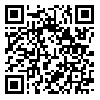Volume 10, Issue 4 (12-2023)
NBR 2023, 10(4): 22-40 |
Back to browse issues page
Download citation:
BibTeX | RIS | EndNote | Medlars | ProCite | Reference Manager | RefWorks
Send citation to:



BibTeX | RIS | EndNote | Medlars | ProCite | Reference Manager | RefWorks
Send citation to:
Ghandchi H, Ramezani R, Moosavinejad Z. Comparative study of several laboratory methods for isolating exosomes from bovine milk. NBR 2023; 10 (4) : 2
URL: http://nbr.khu.ac.ir/article-1-3624-en.html
URL: http://nbr.khu.ac.ir/article-1-3624-en.html
Alzahra University , re.ramezani@alzahra.ac.ir
Abstract: (4556 Views)
Recently, milk exosomes have attracted much attention from researchers due to their availability and efficiency in cosmetic products and also as drug delivery nanocarriers. Since it is very important to find a simple and efficient method to purify these vesicles, in this research some methods of exosome isolation from bovine milk such as ultracentrifugation, using PEG polymer and several commercial kits were discussed and characterized. Detection of exosomes has been done using DLS and electron microscopy.
In ultracentrifugation, as the most common method of exosome isolation, the number of particles in the electron microscope images was estimated to be very low (5 ± 2 particles), while in the microscopic images of the Exosun kit, a large number of exosomes (150 ± 30 particles) was visible. In PEG precipitation, the average diameter of the particles in DLS results was 263 nm and more than the ultracentrifugation, Exocib and Anaexo kit, where the diameter of the particles was 176 nm, 142 nm, and 123 nm, respectively. The average diameter of the particles in the microscopic images of the Exosun kit was 30-70±10 nm, and DLS results confirmed the small size of the isolated particles. Considering the large number of small particles (≥ 30nm) in the microscopic results of the exosun kit, other methods may not have been able to isolate these small particles. Finally, although all the studied methods were able to isolate exosome from milk, more extensive studies are necessary to make a more accurate comparison and to introduce a standard method for isolating exosome from bovine's milk.
In ultracentrifugation, as the most common method of exosome isolation, the number of particles in the electron microscope images was estimated to be very low (5 ± 2 particles), while in the microscopic images of the Exosun kit, a large number of exosomes (150 ± 30 particles) was visible. In PEG precipitation, the average diameter of the particles in DLS results was 263 nm and more than the ultracentrifugation, Exocib and Anaexo kit, where the diameter of the particles was 176 nm, 142 nm, and 123 nm, respectively. The average diameter of the particles in the microscopic images of the Exosun kit was 30-70±10 nm, and DLS results confirmed the small size of the isolated particles. Considering the large number of small particles (≥ 30nm) in the microscopic results of the exosun kit, other methods may not have been able to isolate these small particles. Finally, although all the studied methods were able to isolate exosome from milk, more extensive studies are necessary to make a more accurate comparison and to introduce a standard method for isolating exosome from bovine's milk.
Article number: 2
Type of Study: Original Article |
Subject:
Biotechnology
Received: 2023/05/10 | Revised: 2024/07/14 | Accepted: 2023/10/14 | Published: 2024/03/13 | ePublished: 2024/03/13
Received: 2023/05/10 | Revised: 2024/07/14 | Accepted: 2023/10/14 | Published: 2024/03/13 | ePublished: 2024/03/13
Send email to the article author
| Rights and permissions | |
 |
This work is licensed under a Creative Commons Attribution-NonCommercial 4.0 International License. |






